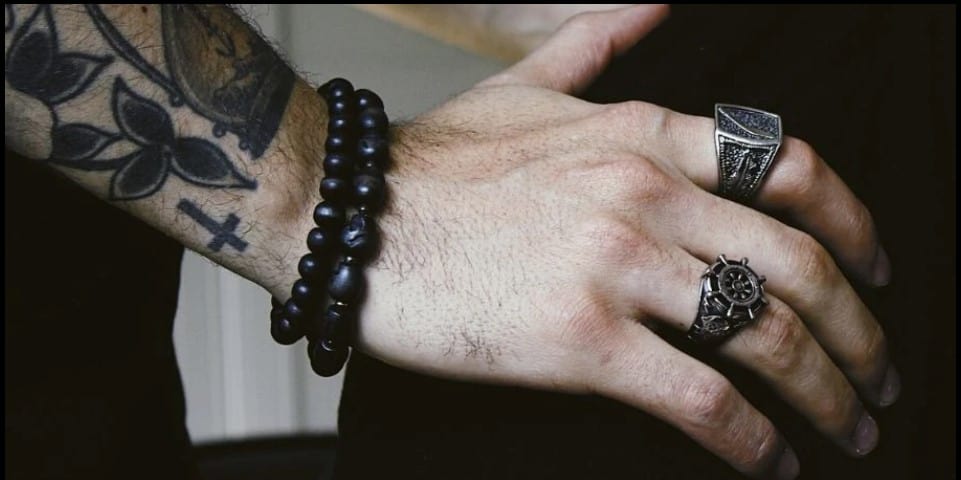Latest News
The History and Significance of Gothic Rings

Gothic is an art trend dominated in Europe from the 12th to the 15th centuries. Starting with architecture, Gothic gradually encompassed sculpture, painting, book miniature, stained glass, fashion, and, of course, jewelry. It is not really correct to call the Gothic fashion style. Rather, it is a lifestyle.
In the Gothic era, jewelry reflected the status and wealth of its owner. In the majority of medieval states, commoners couldn’t wear jewelry made of precious metals. Even if they could afford a gold ring, they were forbidden to put it on (affluent members of the society, however, could freely wear lavish ornaments, though many of them bore a functional significance rather than decorative). Catholic Church dictated that believers couldn’t flaunt garish jewelry, and since Gothic is basically an evolution of cathedral architecture, it followed the rules of religious dogma. It also means that we can see many religious symbols in Gothic art including crosses, the tree of life, vine, etc.
Two Trend of Medieval Gothic
- Symbolic items
Because Gothic stemmed from Christian architecture, religion impacted its components. Take across, for instance. While crosses still personified the dogmas and beliefs of the Catholic Church, Gothic made use of the emotional power of art like no other period in the history of mankind. Just like those cathedrals and temples, crosses were crafted large, intricate, and highly ornate to highlight the significance of the supreme power while belittling a person.
A crown, as symbols of power, also repeated the architectural ideas of the cathedrals in miniature. Gothic crowns pointed their prongs to the sky mimicking cathedrals’ spiels. These symbols of the royal authority always contain heraldic signs and embellishment of multicolored precious stones that resembled stained glass windows of temples.
2.Utilitarian jewelry as part of the attire
At first, jewelry and accessories didn’t consider to be decorative elements. Rather, they performed a certain utilitarian function. One of the first pieces of ‘jewelry’ that combined both beauty and functionality were buttons. In Europe, they appeared only during the Crusades (crusaders brought them from East), and soon enough, they became a popular accessory among riches. Buttons were pretty expensive to craft at that time so a few buttons featured in a dress cost more than all the fabric.
Rings also performed a functional role. Every person who had power or importance used them as signets to seal correspondence and documents. Along with that, they carried the significance of an amulet. Especially popular were rung with gemstone inlays. Their symbolical meaning varied depending on their size and color intensively. By the way, medieval people didn’t always keep the rules of wearing rings on their fingers. In England, for example, they often tied their signets to wrists, and in Germany, men attached them to their hats.
Besides rings and buttons, the Gothic influence is seen in buckles, fasteners, combs, hairpins, and brooches.
Features of the First Gothic Jewelry Items
Real silver gothic rings (and gold, too) of the medieval era benefited from cloisonne enamel techniques, large cabochon gemstones, and multicolor inserts. Diamonds, turquoise, garnets, rubies, emeralds, and pearls were the favorite jewels of that era. As you can see, the medieval Gothic ornaments have little in common with modern ones. Back then, jewelry was a real riot of colors while modern Gothic sticks to black and silver. The pops of colors can still be seen but they are not near as sweeping as in the old Gothic.
Neogothic
After the period of its heyday, Gothic fell into oblivion for about four centuries. However, the XIX century introduced a revival of neo-styles. Hard on the heels of the Napoleonic Wars, Europe succumbed to a romantic mood and gave birth to the first of neo-styles, the Neo-Gothic. The motherland of this style became England. One of the favorite entertainments of the aristocracy of that time was themed balls. Ladies and gentlemen put on lush ornate dresses and costumes, and thus clothing and jewelry imitating items of the Middle Ages came into fashion in the early 1800s.
Neo-Gothic jewelry is built upon religious images, mythical animals, floral patterns, crosses of various shapes, shields, crowns, individual letters of the Gothic font, and phrases in Latin. Gemstones were a less common option in comparison to the Middle Ages. Instead, rings, necklaces, and headpieces were made of gold or oxidized silver with commonplace enamel accents. This era also brought to us castiron jewelry.
At first, castiron jewelry was only a symbol of mourning (because its color is black) and was affordable to everyone. However, during the numerous wars sweeping Europe in the 19 century, it quickly became a symbol of patriotism and fidelity. Women donated their gold jewelry for the needs of the army and received cast iron items in return. Perhaps due to the Neo-Gothic, black color became an integral companion of the modern Gothic image.
Neo-Gothic lasted until the1850s and then quickly gave way to the style of archaeological revival. Without this short resurgence, however, we probably would not have witnessed its reincarnation in the 20th century. The Goths of the modern era gravitate toward dark, deep colors, silver rings adorned with outlandish symbols, and make-up to match.
Addison is a student of the Aust Abbottabad University of Science and Technology. He started his graduation in 2016 and graduated in 2020. I’m a professional article and blog writer, has written dozens of content on different topics and worked with professionals all over the globe. Feel free to contact me for any assistance. [email protected]










